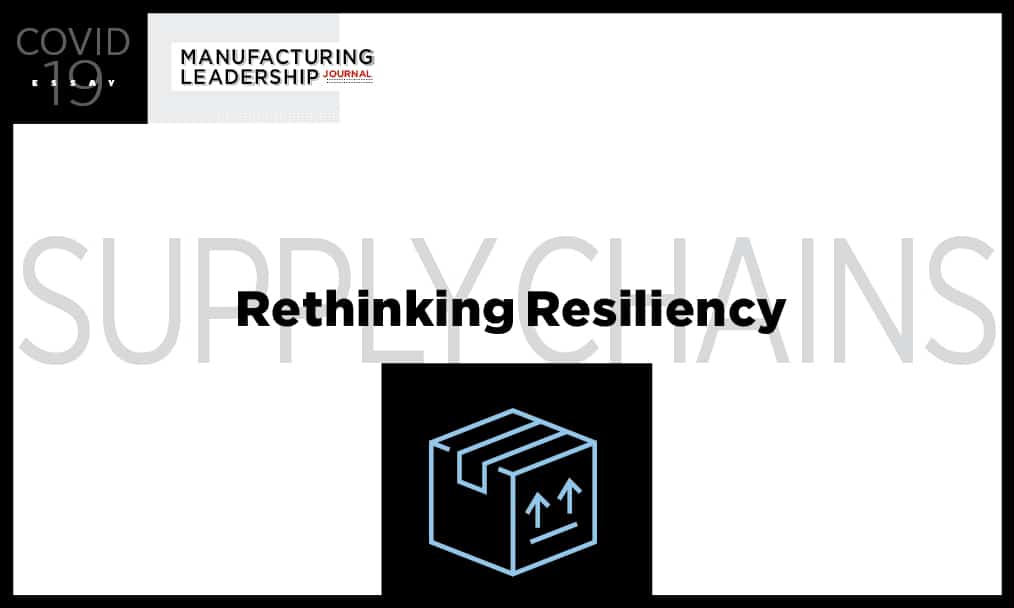
Will the COVID crisis mark an end to the era of long, complex, global supply chains?
Planning for disruption is a fundamental requirement for any modern supply chain. Over the last decade hurricanes, floods, tsunamis, earthquakes, political unrest, military conflicts, trade wars, and even the odd volcano, have taught manufacturing supply chain planners that sudden disruption can happen anywhere, at any time, and have significant impacts on the business.
Few, however, had adequate plans in place to cope with the widespread global COVID-19 pandemic that has hit the world’s manufacturing supply networks over the last few months. With factories closing down from Wuhan to Wichita, goods and critical components trapped in transit at foreign ports or airfields, and around a third of the world’s workers and consumers in lockdown, the supply chain disruption caused by the COVID pandemic has been massive and unprecedented.
No matter how quickly individual countries strive to get their industries back up to speed, the pandemic’s implications are likely to ripple through industrial supply network ecosystems for many years to come.
“The simple learning for all of us is that the longer the supply chain is, the longer it takes to recover from an issue like COVID-19,” says Michael Bosbach, Global Corporate Manufacturing Director at Procter & Gamble (P&G). “With longer supply chains you have multiple steps and multiple regions involved – from raw materials, to production, to the point where we deploy the finish product – so it’s complex and it takes much longer. I foresee that we will try to make supply chains much more local in the future to reduce that delay and complexity.”
Over recent decades, those longer global supply chains have often been a product of the industry’s desire to achieve costs savings, outshoring the production of both products and components to emerging economies to benefit from lower labor costs and higher-volume production. But that global strategy has created intrinsic vulnerabilities.
“At the end of the day, we have developed our supply chains in order to save money,” continues Bosbach. “But we may have done that too much, and now, when issues like this happen, you see that your resiliency is suffering because the supply chains are so long, and the reaction time to supply disruption is much longer.”
Building greater resiliency into supply chains has catapulted up to one of the top priorities for many manufacturing companies in the wake of the COVID crisis. In the Manufacturing Leadership Council’s latest survey on the impact of COVID-19 on manufacturing, for example, almost two thirds of manufacturing executives highlight an urgent need for an increased focus on supply chain resiliency as a critical factor for the future and one of the key lessons they have learned as they begin to emerge from the pandemic.
“We will need digital tools to enable us to find the optimum solutions to deal with future issues.”
But that pursuit of greater resiliency is not just about improved visibility and being able to better anticipate potential disruptions. It’s also about a company’s active ability to react swiftly to mitigate risks and manage a successful response to any disruption.
As Simon Ellis, Vice President of Supply Chain Strategies at IDC, puts it: “It is not enough to have clarity into supply chain risks, though that is an important consideration; it is also necessary to be able to take the necessary corrective steps, both proactively and reactively, to ensure that disruptions do not persist and the time to recovery is optimized.”
And that may require a whole new strategic approach to what manufacturing supply chain resiliency means for the future.
“We need to rethink what we mean by resiliency,’ believes Jag Srai, Head of the Center for Manufacturing at the Institute for Manufacturing (IfM) at the University of Cambridge in the U.K. “I think resilience is now going to take on a broader theme around being able to organize and draw on manufacturing capability and end-to-end supply chain systems which can respond to shocks. Being able to connect manufacturing, seamlessly, with demand is going to be crucial. New technologies have a very interesting role to play in that.”
M4.0 technologies will be one of the keys to unlock that broader approach to resiliency, from the ability to share digital designs around the world, to digital twins that allow companies to easily replicate production across multiple locations, to advanced analytics that provide instant visibility and valuable predictive insights.
“We will need digital tools to enable us to find the optimum solutions to deal with future issues or spikes in demand and drive a much faster response than we have today,” predicts P&G’s Bosbach. “Analytics, AI, external data integration with our suppliers, and the digital twin concept that can mirror physical operations and physical supply chains to monitor different supply chain scenarios, will certainly help us to quickly decide what is needed and what we need to do to react quickly. These are all very critical.”
So manufacturing supply chains will clearly change in the wake of the pandemic. They will be shorter, less complex, increasingly driven by customer proximity, more resilient, technology empowered, more adaptable in a crisis, and faster to respond. M